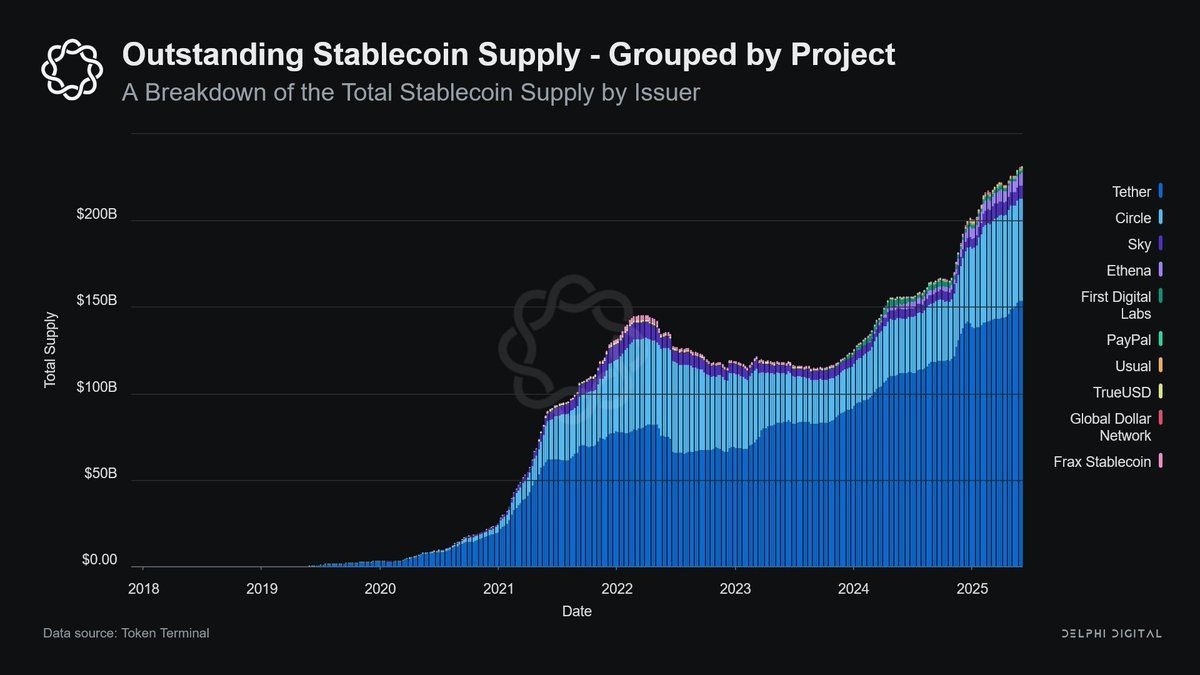| COINOTAG recommends • Exchange signup |
| 💹 Trade with pro tools |
| Fast execution, robust charts, clean risk controls. |
| 👉 Open account → |
| COINOTAG recommends • Exchange signup |
| 🚀 Smooth orders, clear control |
| Advanced order types and market depth in one view. |
| 👉 Create account → |
| COINOTAG recommends • Exchange signup |
| 📈 Clarity in volatile markets |
| Plan entries & exits, manage positions with discipline. |
| 👉 Sign up → |
| COINOTAG recommends • Exchange signup |
| ⚡ Speed, depth, reliability |
| Execute confidently when timing matters. |
| 👉 Open account → |
| COINOTAG recommends • Exchange signup |
| 🧭 A focused workflow for traders |
| Alerts, watchlists, and a repeatable process. |
| 👉 Get started → |
| COINOTAG recommends • Exchange signup |
| ✅ Data‑driven decisions |
| Focus on process—not noise. |
| 👉 Sign up → |
-
Stablecoin supply has surged past $250 billion, driven by significant Treasury bond holdings and growing market adoption, signaling a pivotal moment for the crypto ecosystem.
-
The potential approval of the GENIUS Act could catalyze a tenfold increase in stablecoin market capitalization, reflecting heightened interest from issuers, exchanges, and investors alike.
-
Despite optimistic forecasts, industry experts caution about liquidity risks and the concentrated dominance of Tether and Circle amid evolving regulatory scrutiny.
Stablecoin supply tops $250B with $120B in Treasurys locked; GENIUS Act may boost market cap 10x amid growing adoption and regulatory challenges.
Stablecoin Supply Surpasses $250 Billion Amid Market Expansion
Recent analysis from Delphi Digital reveals that the stablecoin market has expanded beyond $250 billion, with Tether and Circle collectively commanding approximately 86% of the total market share. This growth is underpinned by over $120 billion in US Treasury bonds locked within stablecoin reserves, highlighting the sector’s increasing integration with traditional financial instruments.
Market dynamics are shifting as issuer diversification intensifies; more than ten stablecoins now boast circulating supplies exceeding $100 million. This competitive landscape underscores the sector’s maturation and the broadening appeal of stablecoins as reliable digital assets.

| COINOTAG recommends • Professional traders group |
| 💎 Join a professional trading community |
| Work with senior traders, research‑backed setups, and risk‑first frameworks. |
| 👉 Join the group → |
| COINOTAG recommends • Professional traders group |
| 📊 Transparent performance, real process |
| Spot strategies with documented months of triple‑digit runs during strong trends; futures plans use defined R:R and sizing. |
| 👉 Get access → |
| COINOTAG recommends • Professional traders group |
| 🧭 Research → Plan → Execute |
| Daily levels, watchlists, and post‑trade reviews to build consistency. |
| 👉 Join now → |
| COINOTAG recommends • Professional traders group |
| 🛡️ Risk comes first |
| Sizing methods, invalidation rules, and R‑multiples baked into every plan. |
| 👉 Start today → |
| COINOTAG recommends • Professional traders group |
| 🧠 Learn the “why” behind each trade |
| Live breakdowns, playbooks, and framework‑first education. |
| 👉 Join the group → |
| COINOTAG recommends • Professional traders group |
| 🚀 Insider • APEX • INNER CIRCLE |
| Choose the depth you need—tools, coaching, and member rooms. |
| 👉 Explore tiers → |
Nick Tomaino, founder of 1confirmation, forecasts that the GENIUS Act’s approval could propel the stablecoin market cap to an unprecedented $2.5 trillion, a tenfold increase from current levels. He remarked, “The GENIUS Act is great for crypto and stablecoin market cap will 10x from here ASAP because of it.”
Stablecoins now facilitate over 60% of all cryptocurrency transaction volumes, a significant rise from 35% in 2023, despite the absence of comprehensive federal regulation. Coinbase CEO Brian Armstrong has described stablecoins as a “viral loop,” simplifying user onboarding into the crypto space. Similarly, Eric Golden of Canopy Capital anticipates stablecoins will become the dominant payment mechanism, gradually supplanting traditional transaction methods.
| COINOTAG recommends • Exchange signup |
| 📈 Clear interface, precise orders |
| Sharp entries & exits with actionable alerts. |
| 👉 Create free account → |
| COINOTAG recommends • Exchange signup |
| 🧠 Smarter tools. Better decisions. |
| Depth analytics and risk features in one view. |
| 👉 Sign up → |
| COINOTAG recommends • Exchange signup |
| 🎯 Take control of entries & exits |
| Set alerts, define stops, execute consistently. |
| 👉 Open account → |
| COINOTAG recommends • Exchange signup |
| 🛠️ From idea to execution |
| Turn setups into plans with practical order types. |
| 👉 Join now → |
| COINOTAG recommends • Exchange signup |
| 📋 Trade your plan |
| Watchlists and routing that support focus. |
| 👉 Get started → |
| COINOTAG recommends • Exchange signup |
| 📊 Precision without the noise |
| Data‑first workflows for active traders. |
| 👉 Sign up → |
Emerging Challenges and Regulatory Considerations in Stablecoin Growth
While the stablecoin market exhibits robust growth, it faces notable challenges. The substantial locking of US Treasury bonds—exceeding $120 billion—creates a liquidity sink external to the conventional financial system, raising concerns about systemic risk and capital efficiency, as highlighted by Delphi Digital.
New entrants like Ethena and First Digital Labs are still developing their stablecoin offerings, indicating ongoing innovation but also potential volatility. The market’s reliance on Tether and Circle, which consistently represent at least 4% of the total cryptocurrency market cap, introduces concentration risk that could impact stability if either entity encounters operational difficulties.
| COINOTAG recommends • Traders club |
| ⚡ Futures with discipline |
| Defined R:R, pre‑set invalidation, execution checklists. |
| 👉 Join the club → |
| COINOTAG recommends • Traders club |
| 🎯 Spot strategies that compound |
| Momentum & accumulation frameworks managed with clear risk. |
| 👉 Get access → |
| COINOTAG recommends • Traders club |
| 🏛️ APEX tier for serious traders |
| Deep dives, analyst Q&A, and accountability sprints. |
| 👉 Explore APEX → |
| COINOTAG recommends • Traders club |
| 📈 Real‑time market structure |
| Key levels, liquidity zones, and actionable context. |
| 👉 Join now → |
| COINOTAG recommends • Traders club |
| 🔔 Smart alerts, not noise |
| Context‑rich notifications tied to plans and risk—never hype. |
| 👉 Get access → |
| COINOTAG recommends • Traders club |
| 🤝 Peer review & coaching |
| Hands‑on feedback that sharpens execution and risk control. |
| 👉 Join the club → |
Nonetheless, the anticipated “Stablecoin summer” fueled by the GENIUS Act’s regulatory clarity is expected to foster innovation and expand opportunities for investors and businesses, positioning stablecoins as a cornerstone of the evolving digital economy.
Conclusion
The stablecoin sector stands at a critical juncture, with supply surpassing $250 billion and regulatory frameworks like the GENIUS Act poised to accelerate growth. While the market offers significant opportunities, stakeholders must remain vigilant about liquidity risks and concentration concerns. As stablecoins increasingly underpin crypto transactions and payments, their evolution will be instrumental in shaping the broader financial landscape.
| COINOTAG recommends • Members‑only research |
| 📌 Curated setups, clearly explained |
| Entry, invalidation, targets, and R:R defined before execution. |
| 👉 Get access → |
| COINOTAG recommends • Members‑only research |
| 🧠 Data‑led decision making |
| Technical + flow + context synthesized into actionable plans. |
| 👉 Join now → |
| COINOTAG recommends • Members‑only research |
| 🧱 Consistency over hype |
| Repeatable rules, realistic expectations, and a calmer mindset. |
| 👉 Get access → |
| COINOTAG recommends • Members‑only research |
| 🕒 Patience is an edge |
| Wait for confirmation and manage risk with checklists. |
| 👉 Join now → |
| COINOTAG recommends • Members‑only research |
| 💼 Professional mentorship |
| Guidance from seasoned traders and structured feedback loops. |
| 👉 Get access → |
| COINOTAG recommends • Members‑only research |
| 🧮 Track • Review • Improve |
| Documented PnL tracking and post‑mortems to accelerate learning. |
| 👉 Join now → |








